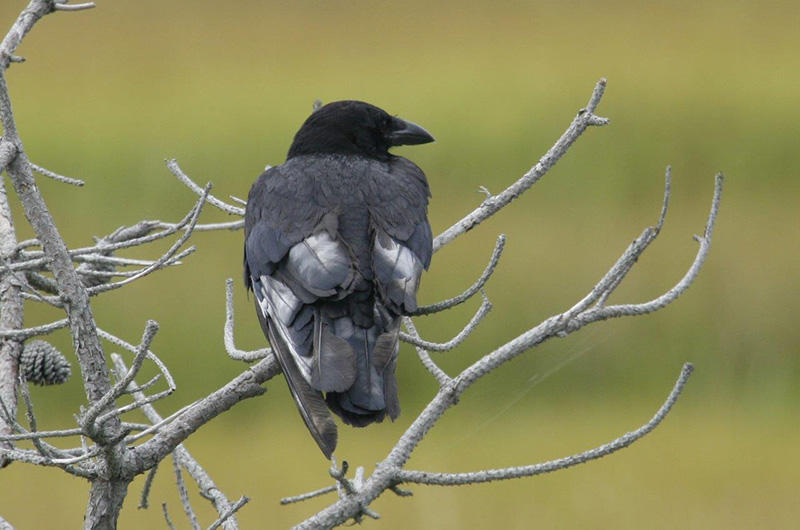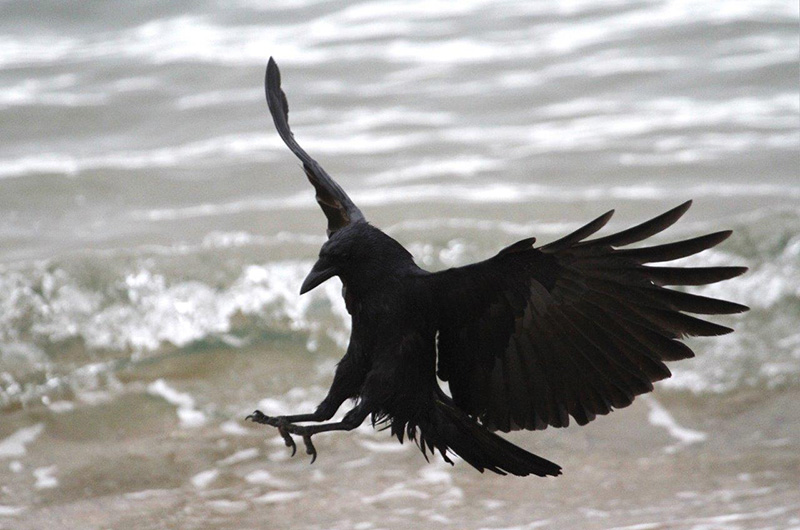As the calendar flips to March in the late winter doldrums, Islanders might be surprised to learn they’re living in the season of the crow.
With hunting seasons over for deer, waterfowl and, on Sunday, the cottontail rabbit, the state’s rules leave Islanders with a motley mix of critters to target, perhaps the most noteworthy being the much-maligned crow.
The black bird, whose caw-caw-caw resonates around the Island, is mostly ignored by hunters, often reviled by farmers and gardeners and shunned by cooks (crow, anyone?).
Yet the crow remains a source of fascination for researchers and bird lovers, and of grudging respect from others, even those who are victimized by its omnivorous nature.
“They are remarkable creatures,” said state ornithologist Andrew Vitz. “They captivate many researchers, and many members of the public as well.”
The crow population on the Island has been fairly stable over the past few decades, supplemented by hundreds of wintertime commuters who fly in from the Cape in the late afternoon and return in the morning, according to Robert Culbert, the Vineyard Gazette bird columnist.
The Island’s most recent Christmas bird count — the day of the year when birders fan out to get a snapshot of populations — identified 1,922 American crows, the highest number in two decades, although Mr. Culbert estimates the actual number might be close to twice that.
Fish crows, a smaller cousin, are counted separately and amounted to another 757 in the survey, most of them commuters. (Their call is more of a nasally ca-ca rather than the deeper caw-caw of the American crow.)
Until about 50 years ago, crows were unprotected and viewed as pests to be shot on sight. With the hunting regulations came an increase in crows and other species. Then about 20 years ago, crow populations were hit hard by the West Nile virus, but they have gradually built back up in Massachusetts.
“They are such an adaptive creature,” said Mr. Vitz. “You probably find them in greater density in urban and suburban areas.”
Despite their abundance and the lack of other legal targets, “We estimate it’s probably less than two per cent of hunters that actually target crows,” he said.
Crows were scarcely the focus of research by ornithologists until the latter part of the last century. But they have been widely recognized as among the most intelligent creatures in the animal kingdom. Just ask Cornell University ornithologist Kevin J. McGowan, who has studied them for 30 years, climbing thousands of trees to observe and tag nestling crows for research.
He’s learned that they have a sophisticated communication system and acute sensitivity to humans.
“They would chase my car down the street to yell at me, he said. “A two-year-old male would follow me on campus, just calling my mom names, insulting my ancestry, telling me how much he disliked me.”
Mr. McGowan became more popular when he began feeding the crows peanuts. At first he had to use a slingshot because they wouldn’t get close, but eventually they’d get within six feet or so. “They recognize my face,” he said. “They recognize my car.”
On the Island, Cooper (Coop) Gilkes 3rd, of Coop’s Bait & Tackle in Edgartown, has witnessed firsthand the ingenuity of the crow. Across from the bait shop is a lot where some employees from neighboring E.C. Cottle’s lumberyard would park. A few years ago, one of the workers was upset because his sack lunch had disappeared from the cab of his pickup, and he suspected his mates. The real culprits were soon revealed.
“A few days later, a crow would land on the top of his truck [and] a second crow would go into the cab and fly away with the bag,” said Mr. Gilkes. “I was shocked. I could not believe it.” So they set up sting operation. “Two days later, here they come again,” he said, one bird serving as the lookout while the other burgled the truck.
Alley Moore, an Oak Bluffs resident and sportsman, has mixed feelings about crows. As a boy, they disturbed his grandmother’s sleep, and as an adult, they attack his fruit trees and harass the hawks he admires.
He would mark the very day fruit on his pear tree would ripen and rise early to thwart the crows. “I swear that morning, I’ll see 20 of them in my tree,” Mr. Moore said. “They will have picked them all, all gone. They’re infuriating — but they’re smart.” (Trying to kill that noisy crow outside his grandmother’s bedroom window is a story for another time.)
At Bayes Norton Farm on the Edgartown-Vineyard Haven Road, Jamie Norton has seen crows attack his tomato crop, a substantial portion of his business. “They take a couple of pecks at one, then move along, peck some more,” he said. The farm stopped growing cantaloupes when they went after the melons.
Mr. Norton uses a special gray, silver and red reflective tape on trellis wire that simulates movement and gives the birds pause. “I had luck last year [when] another farmer gave me a crow that he had shot,” he said. “So I hung it up, and that kept a lot of crows away.”
Not all farmers consider the birds pests. Rebecca Miller, co-owner of North Tabor Farm, is a fan. She credits a flock of 15 to 20 crows as the farm’s early warning system protecting their 250 laying hens from hawks.
“When the red tails come in fall, winter and early spring, the crows let me know they are here,” Ms. Miller said. “So the crows don’t really bother us.” The farm’s three dogs probably help keep the crows honest about the crops, she added.
Mr. Vitz, the state ornithologist, said the state doesn’t tend to get complaints from farmers about crows, but he does field complaints about their appetite for eggs and even nestlings, especially the piping plovers, a threatened shorebird. On occasion, the offending crows are relocated, he said.
The most curious complaint has been from a suburban Boston shopping center, where crows go after windshield wipers on cars. “I’ve thought about what the heck they are trying to do,” Mr. Vitz said. “I haven’t solved that.” He said it’s possible the rubber is used for nests.
Although there’s no conclusive explanation for why the commuters fly to the Vineyard from the Cape to spend the night in roosts, these days, the biggest one may be near Ice House Pond in West Tisbury, where the mass of birds and cacophony of caws around dusk and again in the morning is something to behold. A roost near Lawrence routinely draws 20,000 crows. Mr. McGowan said he has seen them 75,000 strong or larger in upstate New York.
On the Island, crow hunting was relatively popular when naturalist Gus Ben David was growing up in the 1950s and ’60s. For Mr. Gilkes, hunting crows as a kid was simply something to do during an otherwise dead winter. “When I grew up on Martha’s Vineyard, there was nothing else to do,” he quipped.
“Let me tell you, they are sharp,” Mr. Gilkes said. “It’s something to shoot them. You make one mistake, they’re gone.”
This year’s season for hunting crows lasts through April 10, when it’s suspended until July for the breeding season. It then resumes three days a week until April 2022. Except during shotgun deer season, licensed Massachusetts hunters are also allowed to take English sparrows, red and flying squirrels, chipmunks, porcupines, skunks, starlings, weasels and woodchucks year-round.
But the apparent decline in crow hunts may reflect a larger trend: a shrinking hunting culture on the Island. Whether it’s an aging demographic or encroaching development, Mr. Ben David and Mr. Gilkes noted that the number of hunters is in decline.
“Hunting here on the Vineyard, other than deer hunting, has gone way down,” Mr. Ben David said. “We’re losing the hunting culture, as time goes on.”
As for eating crow (literally), Mr. McGowan is perplexed why hunters tend to shoot the bird and toss the carcass in the woods. Sure, people will shy away from scavengers, but there are plenty of recipes for crow on the Internet (sautéed crow breasts, for example) where chefs compare it to pigeon, goose and a less fatty version of duck.
“I don’t get it,” Mr. McGowan said. “It just tastes like goose or [other] dark meat. I’ve had it — it’s fine. It’s gamey but perfectly edible.”










Comments (6)
Comments
Comment policy »